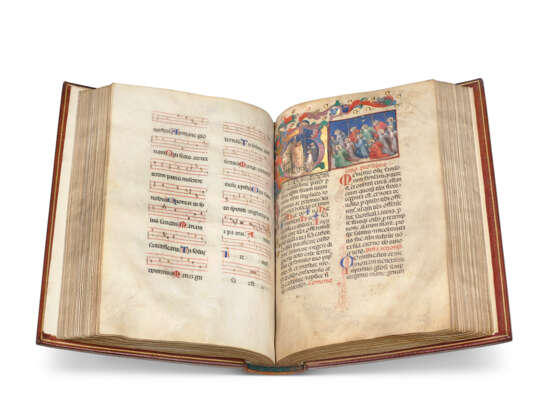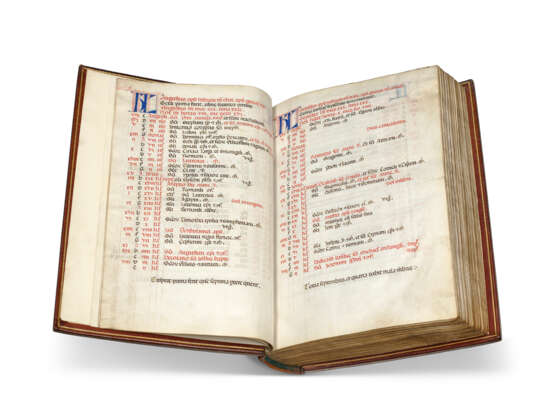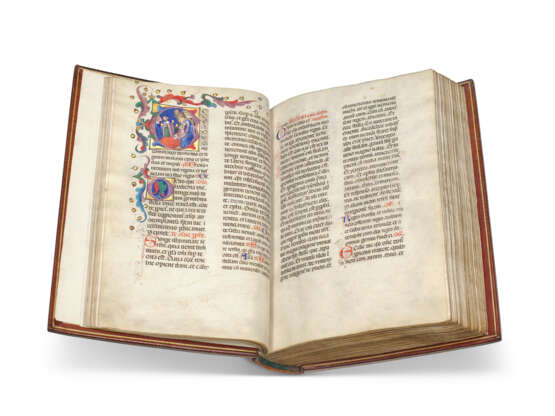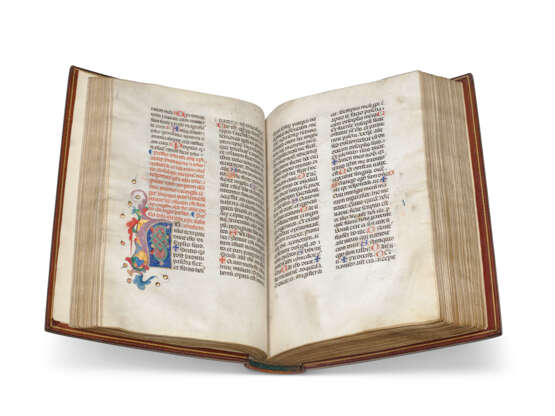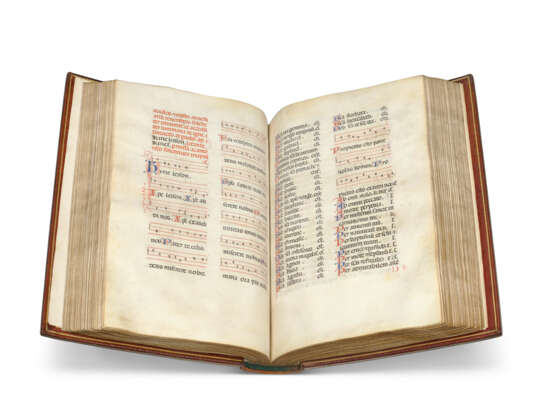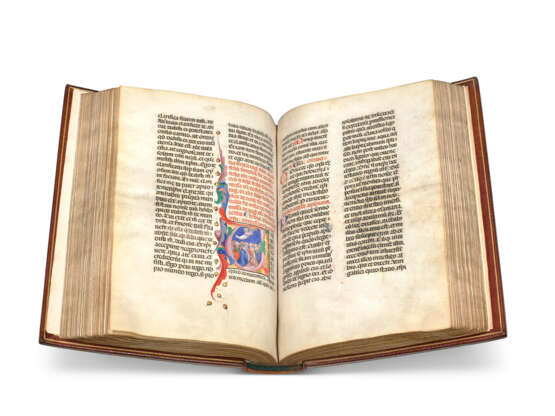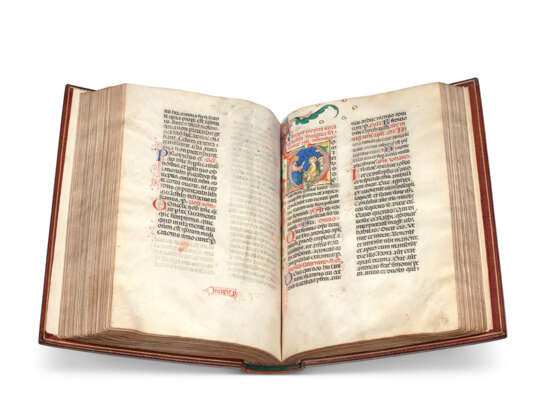ID 1450480
Lot 10 | Maestro degli Statuti padovani
Estimate value
£ 200 000 – 300 000
The Gladstone Missal, use of Rome, in Latin, illuminated manuscript on vellum, Padua, 1420
A sumptuous, dated Paduan Missal, lavishly illuminated by the Maestro degli Statuti padovani for the humanist Bishop of Padua Pietro Marcello, from the collection of William Gladstone.
371 x 255mm. ii + 345 + i, textually complete, collation: 16, 2-1610, 179 (of 10, lacking ix), 18-3510, written in 2 columns of 28 lines, ruled space: 335 x 175mm, catchwords survive in decorative penwork frames throughout, rubrics in red, capitals touched in yellow, initials alternately red or blue with purple or red penwork flourishing extending into the margins, music on four-line red staves, one panel miniature, twelve historiated initials and sixty-three illuminated initials with foliate decoration extending into the margins, f.7 with two historiated initials within a full border of scrolling acanthus and burnished gold bezants inhabited by birds and bearded figures, the bas-de-page incorporating the arms of the Marcello family and the initials ‘F.M.’ (probably lacking a leaf with a full-page Canon miniature after f.154, occasional early corrections to text, some marginal cropping, minor creasing to f.7, opening of the Canon a little darkened, a few smudges, marginal thumbing and signs of use, else generally in excellent condition). Bound in 19th-century diced brown roan, spine tooled in gilt, gilt edges (boards chipped along spine). In a fitted red morocco box, the spine lettered in gilt ‘MISSALE ROMANUM’ (the leather peeling away at the base).
Provenance:
(1) Pietro Marcello (c.1376-1428), Venetian humanist and bishop of Padua, colophon on f.342: ‘Me fecit veneta praeclarus origine scribi Petrus Marcello Patave dignissimus urbis Antistes, patria motus pietate, ducentis quattuor in lustris bis centum annis geminatis’, i.e. ‘The most excellent Petrus Marcello from Venice, worthiest Bishop of the city of Padua, had me written, moved by devotion to his father, in 204 lustrums and 200 twin years [1420]’. The coat of arms of the Marcello family azure a bend wavy or appears on f.7 and is flanked by the initials F. M. on f.7. This is almost certainly the father of Pietro Marcello, Francesco Marcello (d.1419), who on 14 August 1406, in an effort to expand the influence of the family across the Paduan-Venetian plains, acquired a vast tract of land in Monselice from the provveditori of Padua, a city which had only recently come under Venetian control. This strategy of political expansion was definitively consolidated with the appointment of Pietro as Bishop of Padua in 1409.
Francesco Marcello died in 1419: it is likely he who is pictured kneeling before Christ in the large historiated initial on f.7. The smaller historiated initial ‘E’ on the same page shows a younger man with a red cap, red robes, purple bishop’s cape and green book: this must be Pietro Marcello. The portrait bears close resemblance (down to the green book – perhaps this very Missal in its original binding?) to a fresco of the bishop painted by Bartolomeo Montagna in the episcopal palace in Padua. The present manuscript seems therefore to have been commissioned by Pietro in memory of his father, 'patria motus pietate'. The Calendar is adapted for Paduan use: we see additions by the same scribe either squeezed onto the same lines as other feasts or in the margins, including the feasts of Daniel of Padua (3 January), the dedication of Padua Cathedral (24 April), Anthony of Padua (13 June), Justina of Padua (7 October), and Prosdoscimus (7 November).
Pietro Marcello was perhaps a student of Giovanni Conversini da Ravenna (1343-1408), professor of rhetoric at Florence and Padua, whose students included Vittorino da Feltre and Guarino da Verona. He studied law at the University of Bologna, was named Canon of Parenzo in the 1390s, and in 1399 Bishop of Ceneda, where he relocated his entire family. From 1409 he was Bishop of Padua, and during his Paduan tenure he played an important role in the reform of the monasteries of the diocese (most sensationally in the expulsion of the Benedictine nuns from the convent of S. Giacomo di Monselice). One of the main sources we have on his humanist activities is his rich correspondence with Antonio da Romagno, who had several codices of classical authors copied for Pietro between 1402-1404. From these exchanges we discover that Pietro played a major role in the early 15th-century diffusion of classical texts: he owned an early manuscript of Cicero’s letters to Atticus, and was the divulgator of this text to the Venetian humanists Guarino Guarini and Francesco Barbaro and the Paduan humanist Gasperino Barzizza. The latter addressed to Pietro a consolatory work on the death of his brother Girolamo. Pietro was also an author: he composed, among other things, four mock orations by Aeschines, Demades, Demosthenes and ‘a certain Athenian’. He died, probably from the plague, in 1428. On Pietro Marcello, see M. King, Venetian humanism in the age of patrician dominance, 1986, pp.397-8 and M. Bent, ‘Music and the Early Veneto Humanists’, Proceedings of the British Academy, 101, 1999, pp.119-120.
The House of Marcello, by tradition descendants of the Claudii Marcelli of Ancient Rome, was one of the dominant aristocratic forces of Renaissance Venice: notable among its members were Nicolò di Giovanni (1397–1474), doge in 1473; Jacopo di Cristoforo (1413–1484), general da mar, who died during the conquest of Gallipoli; and Pietro di Jacopo Antonio (1446–1530), who took part in the War of Ferrara (1482–1484).
(2) William Ewart Gladstone (1809-1898), four-time Prime Minister of the United Kingdon, Liberal Party politician, and one of the greatest statesmen in British history: Hawarden Castle library armorial bookplate and label ‘M II 9’. By descent to the present owners. The manuscript was lent for exhibition by Henry Neville Gladstone, 1st Baron Gladstone of Hawarden (1852-1935): a descriptive gallery placard is slipped in at the front.
Content:
Calendar ff.1-6v; Temporale, from Advent to Holy Saturday, Order of the Mass, prefaces, litany and sung pieces accompanied by music ff.7-164v; Canon of the Mass ff.165-171; Temporale, from Resurrection Sunday to the 24th Sunday after Pentecost ff.171v-225v; Sanctorale from St Andrew to St Catherine ff.226-285v; Common of Saints and votive masses ff.286-344v.
Illumination:
The vibrant and painterly illumination is by an artist known as the Maestro degli Statuti padovani, named after a ‘Volumen Statutorum Magnificae Civitatis Paduae refformatum sub anno 1420’ (Padova, Biblioteca Civica, ms. BP. 1746). First identified by Giordana Mariani Canova in 1971, the artist is responsible for the illumination of four manuscripts dating from the 1420s: the Statutes after which he is named; a Gradual made for the Church of St Justina at Monselice (Padova, Biblioteca Capitolare, ms. E47); a Canones de montibus corporum supercelestium of Prosdocimo de Beldomandis, astronomy professor at the University of Padua, composed in 1424 (Venice, Biblioteca del Museo Civico Corner, ms. Cicogna 3766 bis); and Paolo Veneto’s In Aristotelis De Anima libros tres Expositio, dating from 1429 (Venice, Biblioteca Nazionale Marciana, ms. Lat. VI, 123=2464).
Rooted in the stylistic conventions of late Paduan trecento – the artist is doubtless aware of the cycle of frescoes by Altichieri in the Cappella di San Giacomo and of those by Jacopo da Verona in the Cappella Bovi – there is nonetheless a fresh, whimsical energy to his forms and compositions. His foliate decoration is bright and rich with acid reds, blues, pinks and cool greens; his use of lead white is pronounced, and his non-figurative initials are often decorated with star-shaped motifs. The compositions stray from the traditions of the trecento in their modern, vibrant naturalism, and the figures are often rendered with soft, painterly strokes. Our Missal is particularly close to the Gradual in Padua made for St Justina at Monselice: almost identical, for example, are the compositions depicting the Nativity (f.19v in the Gradual in Padua, f.18 in our manuscript) – we see the same layout, with the Virgin kneeling in prayer on the left and Joseph sitting on the right, hand supporting his nodding head, and the same rendering of the faces, the animals, and the straw-roofed barn. The Gradual in Padua, and our manuscript too, have strong stylistic links to the whole series of choirbooks produced for St Justina at Monselice at the beginning of the 15th century (Padua, Biblioteca Capitolare, mss. E18, 19, 20, 22, 23 and 24 – see also La Miniatura a Padova dal medioevo al settecento, 1999, esp. pp.209-210).
Particularly striking in the Missal of Pietro Marcello is the miniature opening the Canon of the Mass, laid out across two columns and depicting the Elevation of the Eucharist and kneeling, candle-carrying angels.
The subjects of the historiated initials and the miniature are as follows: Francesco Marcello kneeling in adoration before Christ Pantocrator f.7; Pietro Marcello holding his Missal f.7; Nativity f.18; Adoration of the Magi f.25v; Elevation of the host with a panel miniature with candle-holding angels kneeling in prayer f.165; Resurrection of Christ f.171v; Ascension f.184v; Pentecost f.189; the Calling of Sts Peter and Andrew f.226; Presentation of Christ in the Temple f.235; Annunciation f.239v; Dormition and Assumption of the Virgin f.266v; Nativity of the Virgin f.272.
| Place of origin: | Italy, Europe |
|---|---|
| Auction house category: | Medieval & renaissance manuscripts, Books and manuscripts |
| Place of origin: | Italy, Europe |
|---|---|
| Auction house category: | Medieval & renaissance manuscripts, Books and manuscripts |
| Address of auction |
CHRISTIE'S 8 King Street, St. James's SW1Y 6QT London United Kingdom | |
|---|---|---|
| Preview |
| |
| Phone | +44 (0)20 7839 9060 | |
| Buyer Premium | see on Website | |
| Conditions of purchase | Conditions of purchase |

